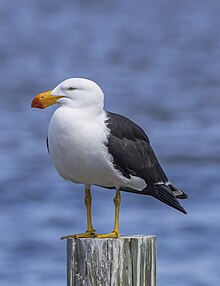
Sauria is the clade of diapsids containing the most recent common ancestor of Archosauria and Lepidosauria, and all its descendants. Since most molecular phylogenies recover turtles as more closely related to archosaurs than to lepidosaurs as part of Archelosauria, Sauria can be considered the crown group of diapsids, or reptiles in general. Depending on the systematics, Sauria includes all modern reptiles or most of them as well as various extinct groups.
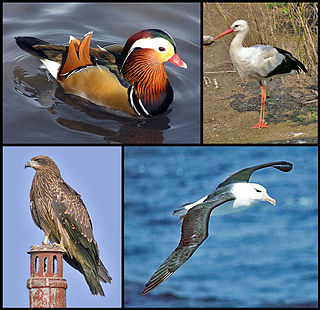
Neognathae is an infraclass of birds, called neognaths, within the class Aves of the clade Archosauria. Neognathae includes the majority of living birds; the exceptions being the tinamous and the flightless ratites, which belong instead to the sister taxon Palaeognathae. There are nearly 10,000 living species of neognaths.

Avicephala is a potentially polyphyletic grouping of extinct diapsid reptiles that lived during the Late Permian and Triassic periods characterised by superficially bird-like skulls and arboreal lifestyles. As a clade, Avicephala is defined as including the gliding weigeltisaurids and the arboreal drepanosaurs to the exclusion of other major diapsid groups. This relationship is not recovered in the majority of phylogenetic analyses of early diapsids and so Avicephala is typically regarded as an artificial or unnatural grouping. However, the clade was recovered again in 2021 following a redescription of Weigeltisaurus, raising the possibility that the clade may be valid after all, although subsequent analyses have not supported this result.

Avemetatarsalia is a clade of diapsid reptiles containing all archosaurs more closely related to birds than to crocodilians. The two most successful groups of avemetatarsalians were the dinosaurs and pterosaurs. Dinosaurs were the largest terrestrial animals for much of the Mesozoic Era, and one group of small feathered dinosaurs has survived up to the present day. Pterosaurs were the first flying vertebrates and persisted through the Mesozoic before dying out at the Cretaceous-Paleogene (K-Pg) extinction event. Both dinosaurs and pterosaurs appeared in the Triassic Period, shortly after avemetatarsalians as a whole. The name Avemetatarsalia was first established by British palaeontologist Michael Benton in 1999. An alternate name is Pan-Aves, or "all birds", in reference to its definition containing all animals, living or extinct, which are more closely related to birds than to crocodilians.

Megalaimidae, the Asian barbets, are a family of birds, comprising two genera with 35 species native to the forests of the Indomalayan realm from Tibet to Indonesia. They were once clubbed with all barbets in the family Capitonidae but the Old World species have been found to be distinctive and are considered, along with the Lybiidae and Ramphastidae, as sister groups.

Neoaves is a clade that consists of all modern birds with the exception of Palaeognathae and Galloanserae. This group is defined in the PhyloCode by George Sangster and colleagues in 2022 as "the most inclusive crown clade containing Passer domesticus, but not Gallus gallus". Almost 95% of the roughly 10,000 known species of extant birds belong to the Neoaves.

Aequornithes, or core water birds, are defined in the PhyloCode as "the least inclusive crown clade containing Pelecanus onocrotalus and Gavia immer".
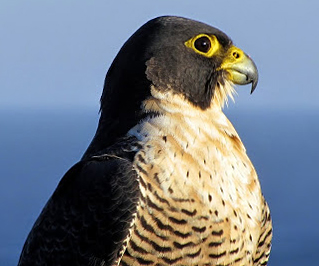
The order Falconiformes is represented by the extant family Falconidae and a handful of enigmatic Paleogene species. Traditionally, the other bird of prey families Cathartidae, Sagittariidae (secretarybird), Pandionidae (ospreys), Accipitridae (hawks) were classified in Falconiformes. A variety of comparative genome analyses published since 2008, however, found that falcons are part of a clade of birds called Australaves, which also includes seriemas, parrots and passerines. Within Australaves falcons are more closely related to the parrot-passerine clade than they are to the seriemas. The hawks, vultures and owls are placed in the clade Afroaves.

Psittacopasseres is a taxon of birds consisting of the Passeriformes and Psittaciformes (parrots). Per Ericson and colleagues, in analysing genomic DNA, revealed a lineage comprising passerines, psittacines and Falconiformes. The group was proposed following an alignment of nuclear intron sequences by Shannon Hackett et al. in 2008. It was formally named as Psittacopasserae in a 2011 Nature Communications article by Alexander Suh and other authors working with Jürgen Schmitz's group, based on genetic analysis of the insertion of retroposons into the genomes of key avian lineages over the course of evolution during the Mesozoic Era. This clade was defined in the PhyloCode by George Sangster and colleagues in 2022 as the least inclusive crown clade containing Psittacus erithacus and Passer domesticus.

Strisores, sometimes called nightbirds, is a clade of birds that includes the living families and orders Caprimulgidae, Nyctibiidae (potoos), Steatornithidae (oilbirds), Podargidae (frogmouths), Apodiformes, as well as the Aegotheliformes (owlet-nightjars) whose distinctness was only recently realized. The Apodiformes and the Aegotheliformes form the Daedalornithes.
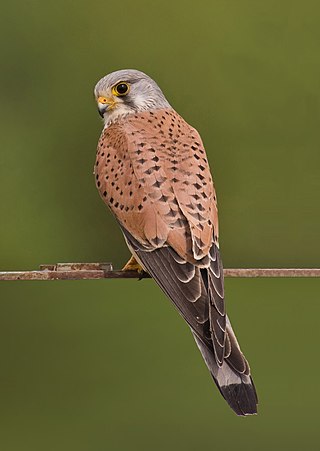
Australaves is a clade of birds, defined in 2012, consisting of the Eufalconimorphae as well as the Cariamiformes. They appear to be the sister group of Afroaves. This clade was defined in the PhyloCode by George Sangster and colleagues in 2022 as "the least inclusive crown clade containing Cariama cristata and Passer domesticus".

Afroaves is a clade of birds, consisting of the kingfishers and kin (Coraciiformes), woodpeckers and kin (Piciformes), hornbills and kin (Bucerotiformes), trogons (Trogoniformes), cuckoo roller (Leptosomiformes), mousebirds (Coliiformes), owls (Strigiformes) and raptors (Accipitriformes). The most basal clades are predatory, suggesting the last common ancestor of Afroaves was also a predatory bird. This group was defined in the PhyloCode by George Sangster and colleagues in 2022 as "the least inclusive crown clade containing Accipiter nisus, Colius colius, and Picus viridis, but not Passer domesticus".

Telluraves is a recently defined clade of birds defined by their arboreality. Based on most recent genetic studies, the clade unites a variety of bird groups, including the australavians as well as the afroavians. This grouping was defined in the PhyloCode by George Sangster and colleagues in 2022 as "the least inclusive crown clade containing Accipiter nisus and Passer domesticus". They appear to be the sister group of the Phaethoquornithes.

Passerea is a clade of neoavian birds that was proposed by Jarvis et al. (2014). Their genomic analysis recovered two major clades within Neoaves, Passerea and Columbea, and concluded that both clades appear to have many ecologically driven convergent traits.

Coraciimorphae is a clade of birds that contains the order Coliiformes (mousebirds) and the clade Cavitaves. The name however was coined in the 1990s by Sibley and Ahlquist based on their DNA-DNA hybridization studies conducted in the late 1970s and throughout the 1980s. However their Coraciimorphae only contains Trogoniformes and Coraciiformes. Coraciimorphae was defined in the PhyloCode by George Sangster and colleagues in 2022 as "the least inclusive crown clade containing Colius colius and Picus viridis, but not Accipiter nisus or Passer domesticus".

Eucavitaves is a clade that contains the order Trogoniformes (trogons) and the clade Picocoraciae. The group was defined in the PhyloCode by George Sangster and colleagues in 2022 as "the least inclusive crown clade containing Trogon viridis and Picus viridis". The name refers to the fact that the majority of them nest in cavities.

Columbimorphae is a clade/superorder discovered by genome analysis that includes birds of the orders Columbiformes, Pterocliformes (sandgrouse), and Mesitornithiformes (mesites). This group was defined in the PhyloCode by George Sangster and colleagues in 2022 as "the least inclusive crown clade containing Columba oenas, Mesitornis variegatus, and Pterocles alchata". Previous analyses had also recovered this grouping, although the exact relationships differed. Some studies indicated a sister relationship between sandgrouse and pigeons while other studies favored a sister grouping of mesites and sandgrouse instead. This sister relationship of the sandgrouses and mesites was named by George Sangster and colleagues in 2022 as the clade Pteroclimesites and defined in the PhyloCode as "the least inclusive crown clade containing Mesitornis variegatus and Pterocles alchata".
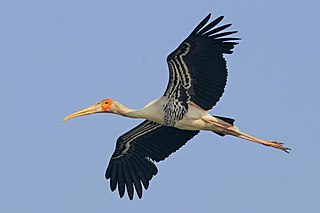
Aequorlitornithes is a clade of waterbirds recovered in a comprehensive genomic systematic study using nearly 200 species in 2015. It contains the clades Charadriiformes, Mirandornithes and Phaethoquornithes. Previous studies have found different placement for the clades in the tree.

Vegaviidae is an extinct family of birds of uncertain phylogenetic placement, which existed during the Late Cretaceous and possibly the Paleocene. Definitive fossils attributed to the family have only been found in Antarctica, though other fossils from the Southern Hemisphere including Chile and New Zealand may represent this group. The putative Campanian vegaviid from Canada known as Maaqwi, more likely belongs to the Procellariformes.

Hieraves is a clade of telluravian birds named by Wu et al. (2024) that includes the orders Strigiformes (owls) and Accipitriformes. The Cathartidae are usually included in Accipitriformes, but some authors treat them as a third order Cathartiformes in the Hieraves. In the past, either owls, New World vultures, and hawks were found to be basal outgroups with respect to Coraciimorphae inside Afroaves, or Accipitriformes and Cathartiformes were recovered as a basal clade in respect to the rest of the members of Telluraves. Houde and Braun (2019) found support for Hieraves, but they were found to be the sister group to Coraciimorphae and Australaves. The analysis of Wu et al. (2024) has found Hieraves to be the sister clade to Australaves. Stiller et al. (2024) found Hieraves to be basal to Afroaves.
